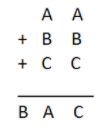
In the following addition, A, B, C represent different digits. Find them and the sum


Answer
570.3k+ views
Hint:
Here we need to observe that by adding once place $A+B+C$ we are getting the first digit as $C$. How it can be possible. Unit place of $A+B$ has to be $0$. Then only on adding it with $C$ we’ll get $C$. Perform the similar analysis for tens place also to get the answer.
Complete step by step solution:
Here we observe that the last digit of $$A + B + C$$ is $$C$$, so that $$A + B = 10$$. Since $$C$$ is a digit, $$C \leqslant 9$$. Hence the carry from unit's place to ten's place is $$1$$.
Since we are adding only $$3$$ digits, the carry in ten's place of the sum cannot exceed $$2$$. Hence B cannot be more than $$2$$. Thus we observe that $$B = 1$$ or $$2$$. The addition of digits in ten's place gives (along with carry 1 from unit's place) $$A + B + C + 1 = 10 + C + 1$$and this must leave remainder $$A$$ when divided by $$10$$.
If $$B = 1$$, then $$A = 9$$ and hence $$C + 1 = 9$$ giving $$C = 8$$. We get $$99 + 11 + 88 = 198$$, which is a correct answer. If $$B = 2$$, you get $$A = 8$$ and $$C + 1 = 8$$ giving $$C = 7$$. But then $$88 + 22 + 77 = 187$$. This does not fit in a hundred's place in the sum is 1 but not 2.
The correct answer is $$99 + 11 + 88 = 198$$.
Note:
To solve such questions we need to understand the number system properly, especially the places and their value. There are a couple of variations of this question. Just to make the question easy, give a known number instead of giving all knowns.
Here we need to observe that by adding once place $A+B+C$ we are getting the first digit as $C$. How it can be possible. Unit place of $A+B$ has to be $0$. Then only on adding it with $C$ we’ll get $C$. Perform the similar analysis for tens place also to get the answer.
Complete step by step solution:
Here we observe that the last digit of $$A + B + C$$ is $$C$$, so that $$A + B = 10$$. Since $$C$$ is a digit, $$C \leqslant 9$$. Hence the carry from unit's place to ten's place is $$1$$.
Since we are adding only $$3$$ digits, the carry in ten's place of the sum cannot exceed $$2$$. Hence B cannot be more than $$2$$. Thus we observe that $$B = 1$$ or $$2$$. The addition of digits in ten's place gives (along with carry 1 from unit's place) $$A + B + C + 1 = 10 + C + 1$$and this must leave remainder $$A$$ when divided by $$10$$.
If $$B = 1$$, then $$A = 9$$ and hence $$C + 1 = 9$$ giving $$C = 8$$. We get $$99 + 11 + 88 = 198$$, which is a correct answer. If $$B = 2$$, you get $$A = 8$$ and $$C + 1 = 8$$ giving $$C = 7$$. But then $$88 + 22 + 77 = 187$$. This does not fit in a hundred's place in the sum is 1 but not 2.
The correct answer is $$99 + 11 + 88 = 198$$.
Note:
To solve such questions we need to understand the number system properly, especially the places and their value. There are a couple of variations of this question. Just to make the question easy, give a known number instead of giving all knowns.
Recently Updated Pages
Master Class 12 Business Studies: Engaging Questions & Answers for Success

Master Class 12 Economics: Engaging Questions & Answers for Success

Master Class 12 English: Engaging Questions & Answers for Success

Master Class 12 Maths: Engaging Questions & Answers for Success

Master Class 12 Social Science: Engaging Questions & Answers for Success

Master Class 12 Chemistry: Engaging Questions & Answers for Success

Trending doubts
What is BLO What is the full form of BLO class 8 social science CBSE

What is meant by exothermic and endothermic reactions class 11 chemistry CBSE

Which places in India experience sunrise first and class 9 social science CBSE

Which animal has three hearts class 11 biology CBSE

Who was the first woman to receive Bharat Ratna?

What are the major means of transport Explain each class 12 social science CBSE




